BEST Traditional Mincemeat
This post may contain affiliate links. See my disclosure policy.
If you’ve never cared for the store-bought stuff or even most homemade versions, you’re not alone. But just wait until you’ve tried this genuinely authentic, old-fashioned homemade mincemeat – it’s a total game-changer! Whether you’ve never liked mincemeat or you’ve always loved it, prepare to either be converted or to fall even more deeply in love! With this authentic mincemeat recipe in hand you’ll be able to make the most scrumptious homemade Mince Pies!
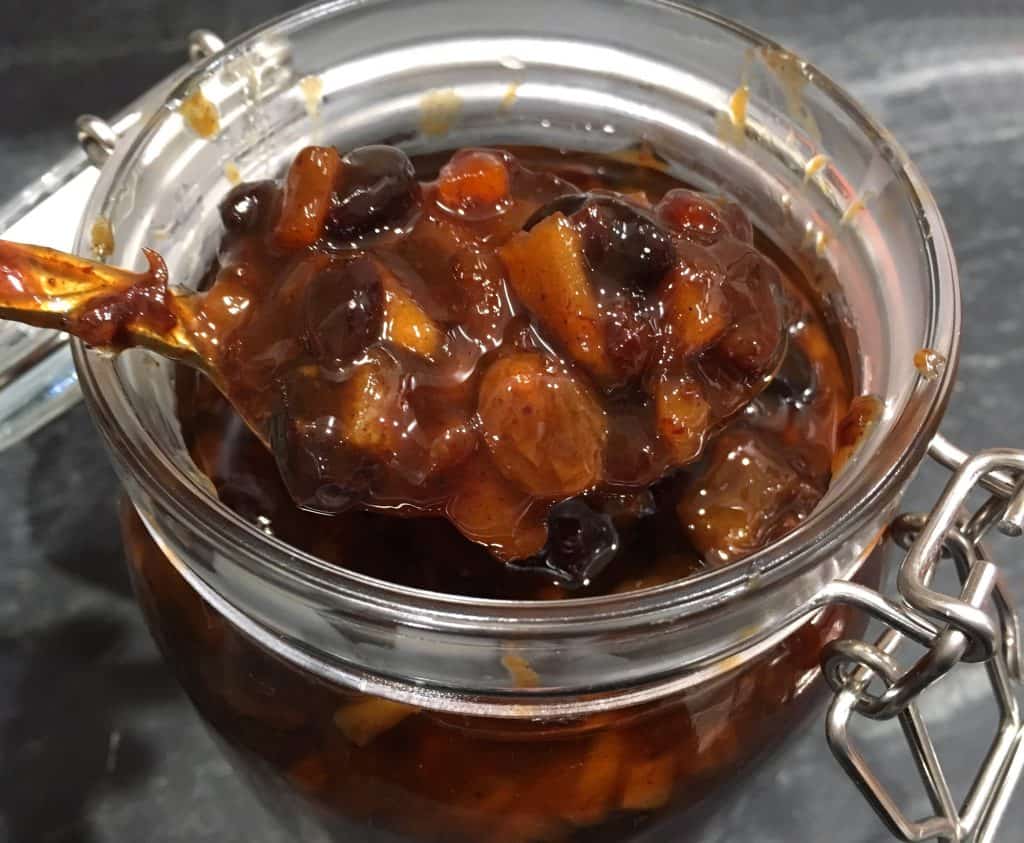
Few people today know the taste of true, authentic mincemeat, a dish dating back to the 11th century. And that explains why very few people I know actually truly enjoy mincemeat versus simply eating it out of tradition (or being forced to so as not to offend Grandma!). Sadly the authentic way of making mincemeat has been largely lost in the last century.
Whatever Happened to Traditional Mincemeat?
And I say lost, not because it’s been erased completely, rather because mincemeat has changed so much, some of its most important elements having been left out, that it just barely resembles its original ancestor. Of the many traditional British dishes that have undergone some form of alteration over the years, mincemeat has probably changed the most. That is largely due to the common omission of mincemeat’s two key ingredients: Meat (traditionally beef or lamb) and suet.
Things like wartime rations on meat, British culinary tastes moving away from sweet-savory combinations, and shifting trends away from the traditional use of suet (read my article on why you should use suet and lard – in short, medical research confirms our ancestors were right after all!) contributed to the gradual moving away from the inclusion of meat and suet in mincemeat. The result of these changes is manifest in the tiny mince pies of today that are almost sickly sweet without the savory meat and suet to round out the flavors and also fairly flat and one-dimensional in flavor profile without the complexity of the savory ingredients. This beloved dish of both the common folk and royalty (savored by generations of kings who enjoyed mince pies during their coronations and at their stately tables) sadly has been reduced to something that is a mere vestige, a residue, of what it once was – the spirits of centuries ago hover over what is passed off today as mincemeat while clenching their fists and wailing in agony.
Okay, that’s a little dramatic.
Essential Ingredients
Many generations ago people would experience mincemeat as a robust and sweet-savory meat-based mixture that conjured up what seemed like a thousand flavor sensations. Pair that with the incomparable texture that suet contributes to pie crust as it’s baked with the mincemeat and it’s no wonder that mincemeat pie was a heralded favorite for many centuries in the United Kingdom and then made its way to become a tradition in Canada, Australia, New Zealand, Ireland, Northern Europe, South Africa, and the New England region of the U.S..
Mince pies are still considered an essential accompaniment to holiday dinners today. But to be truly “traditional”, mincemeat requires meat and suet.

A note about SUGAR: Centuries ago mincemeat was far less sweet than it is today. Though it was made with fruits to add sweetness and to help preserve it (the fructose content), no sugar was added. Feel free to cut back on the brown sugar if you prefer.
A note about MEAT: If you’re put off at the thought of adding meat to mincemeat like our ancestors did for centuries, think of it this way: Imagine a Moroccan tagine – a dish of beef or lamb that is slow cooked with dried fruit, nuts and a myriad of aromatic spices. It’s downright amazing. Mincemeat, which not surprisingly originates from the Crusaders bringing the spices and method back with them from the Middle East, is a very similar concept: Beef that is simmered with dried fruits, nuts and a wonderful host of spices. That doesn’t sound so bad, does it? The mincemeat is stored for a while (under a layer of fat, a centuries-old method of preservation) so the flavors can deepen, and then it’s baked in a flaky pie. Heaven.
Why Make Your Own Candied Citrus Peel?
Another aspect that has always been off-putting to me about mincemeat is the overpowering flavor of the commercial candied citrus peel that’s called for in most recipes. It has a strong chemical-astringent flavor that many people dislike. For that reason I use and highly recommend making your own homemade candied orange peel for this mincemeat. Trust me, the flavor is incomparable and puts the store-bought stuff to miserable shame. And good candied citrus peel gives mincemeat an incredible flavor boost. That said, if you don’t mind store-bought candied citrus peel and want to save yourself the effort, feel free to use it.
Check out our post on how to make Candied Orange Peel.

Why Use Suet?
While you “can” substitute butter (and even coconut oil, though that will greatly alter the flavor), I highly recommend suet for both flavor and texture, especially if you’re making mince pies. If you’ve ever made pie crust with suet you’ll understand – the end result is flaky and flavorful perfection unlike anything else. When you’re baking your mince pies the suet will bake into the pie crust enhancing texture and flavor.
I usually make my own suet when I have access to some kidney fat from locally-raised, grass-fed cows. Check out my tutorial on How to Make Beef Tallow. It’s super easy to make yourself. For a store-bought option I recommend Atora Shredded Beef Suet from England and a household name since 1893, but it’s usually extremely expensive to buy outside the UK.
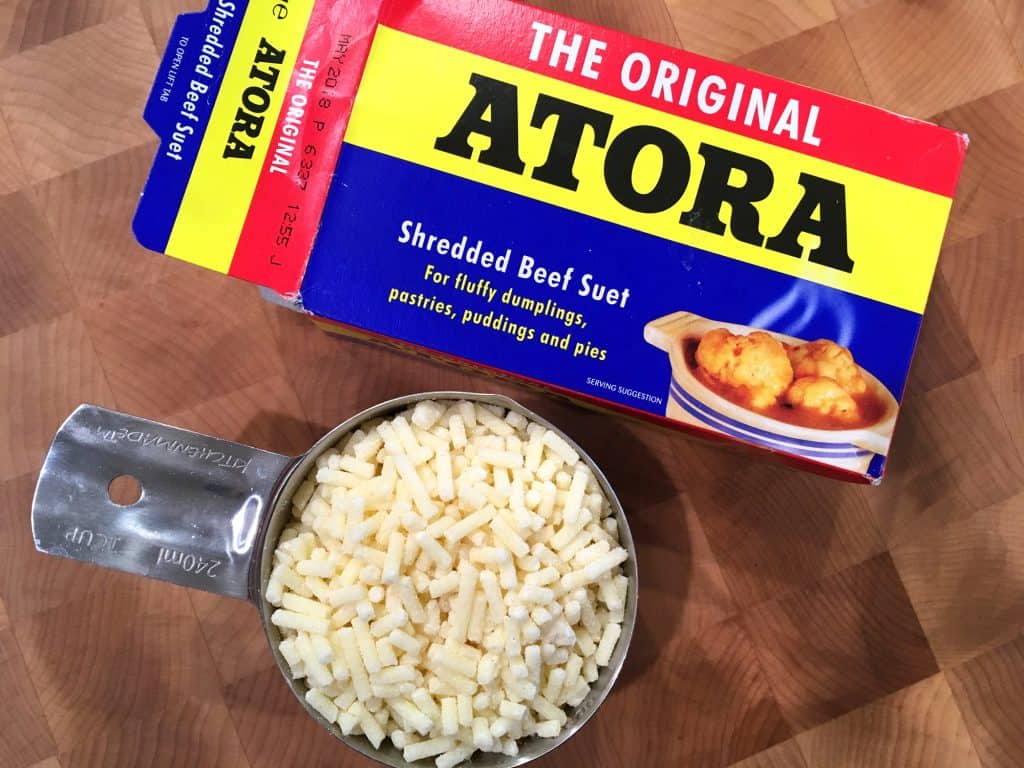
How to Can Mincemeat
A note about PRESERVING: Traditionally mincemeat would be made the year before it’s eaten to give the flavors time do develop and deepen. While time does improve it, it is delicious eaten within just a few days. However, if you want to store it there are several options:
Refrigerator: If you omit the meat it will last for up to a year in clean sterilized jars (some keep it several years in the back of the fridge). The layer of fat on top seals off the mincemeat from any air which results in food deterioration. This is a method of preserving that’s been used for many centuries. If you include the meat it will safely last in your fridge for up to 2 weeks.
Freezer: Either with or without meat, mincemeat can be frozen in airtight containers or in ziplock bags for up to 6 months.
Canning for long-term storage: If you want the traditional meat version to keep longer you can process the quart-sized mason jars (leaving 1 inch headspace) in a pressure canner (not a water bath). Spoon the hot mincemeat into sterilized quart mason jars leaving 1 inch headspace. Use a clean moist rag to wipe off any oil from the jars. Seal and process in a pressure canner according to the time and pressure outlined in the chart below and the mincemeat will keep for up to a year:
| Recommended process time for a dial-gauge pressure canner. | ||||||
| Canner Pressure (PSI) at Altitudes of | ||||||
| Style of Pack | Jar Size | Process Time | 0 – 2,000 ft | 2,001 – 4,000 ft | 4,001 – 6,000 ft | 6,000 – 8,000 ft |
| Hot | Quarts | 90 min | 11 lb | 12 lb | 13 lb | 14 lb |
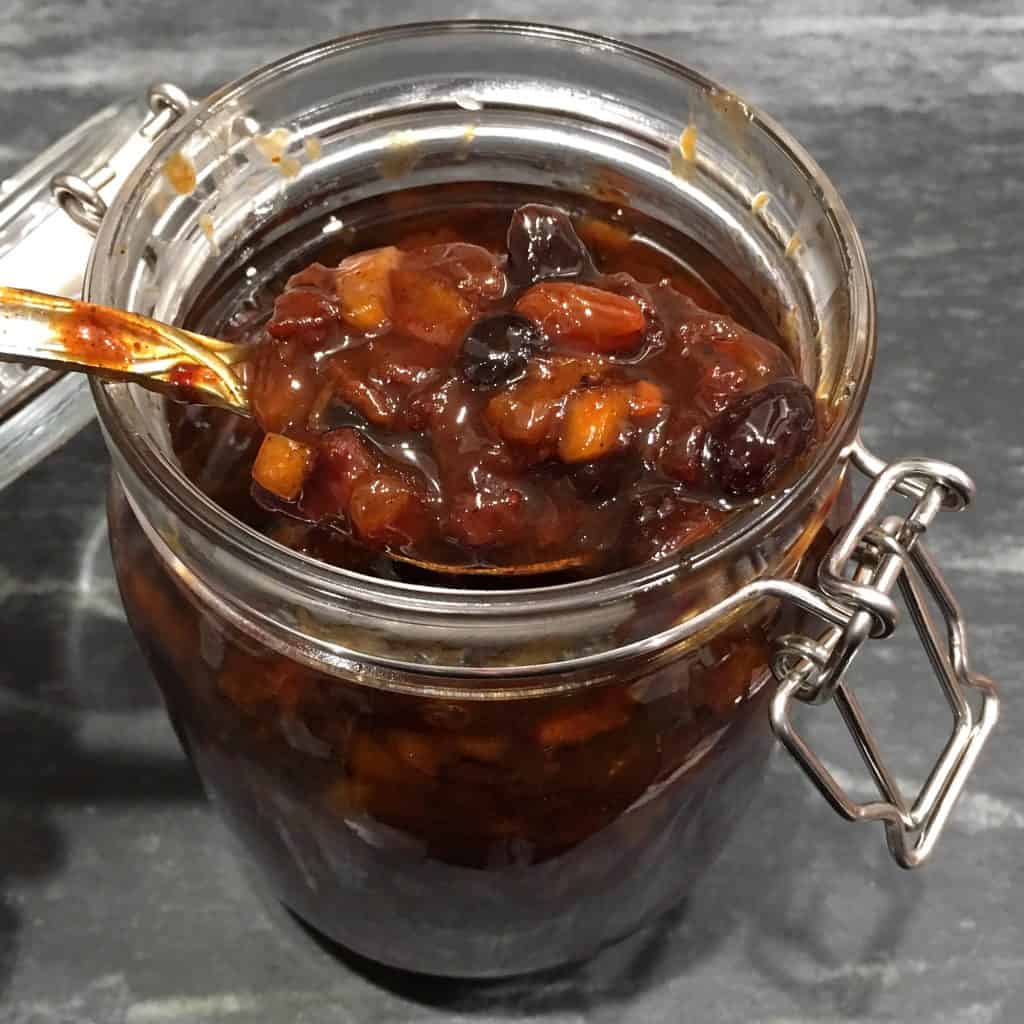
Mincemeat Recipe
Let’s get started!
Combine all of the ingredients, except for the brandy and/or rum in a medium-sized pot.
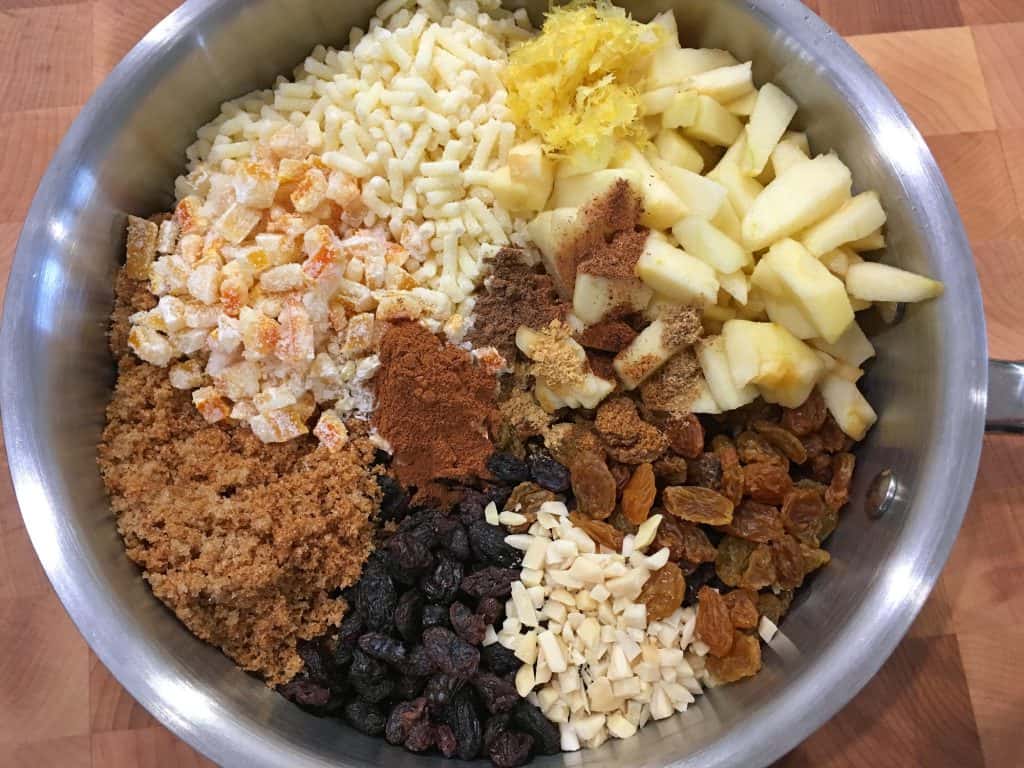
If you’re adding meat, which I highly recommend, you’ll add that at the same time.

Bring it to a boil and then reduce the heat to LOW and simmer uncovered for about 2 hours, stirring occasionally, more towards the end to prevent burning. If the liquid reduces too soon and the mincemeat starts to stick/scorch on the bottom, add a little bit of apple juice or water.
At the end, stir in the brandy and/or rum. If you prefer to have the alcohol cooked out, add it at the same time as the other ingredients (note, the flavor of the brandy/rum will be less pronounced).
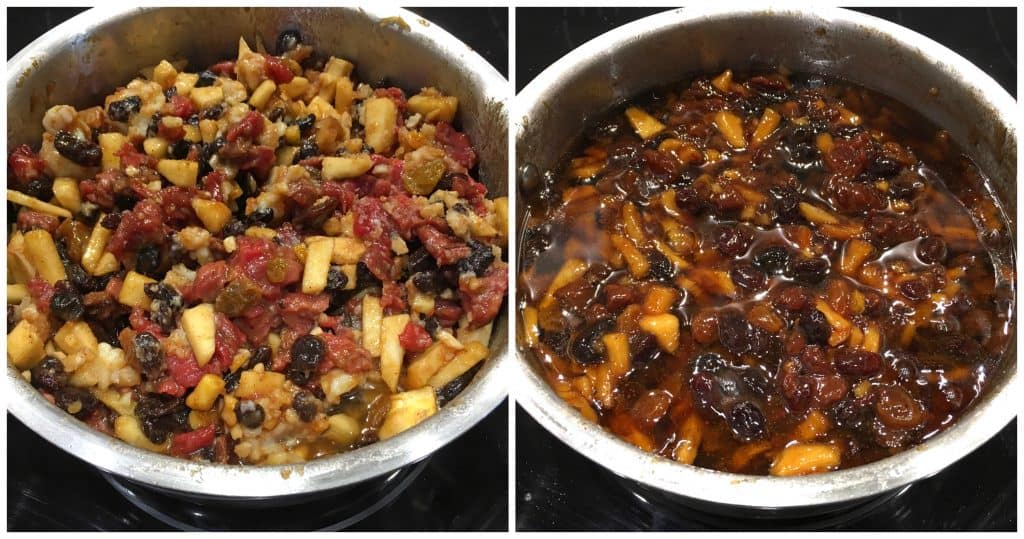
Pour the hot mincemeat into sterilized jars. Let the jars cools.
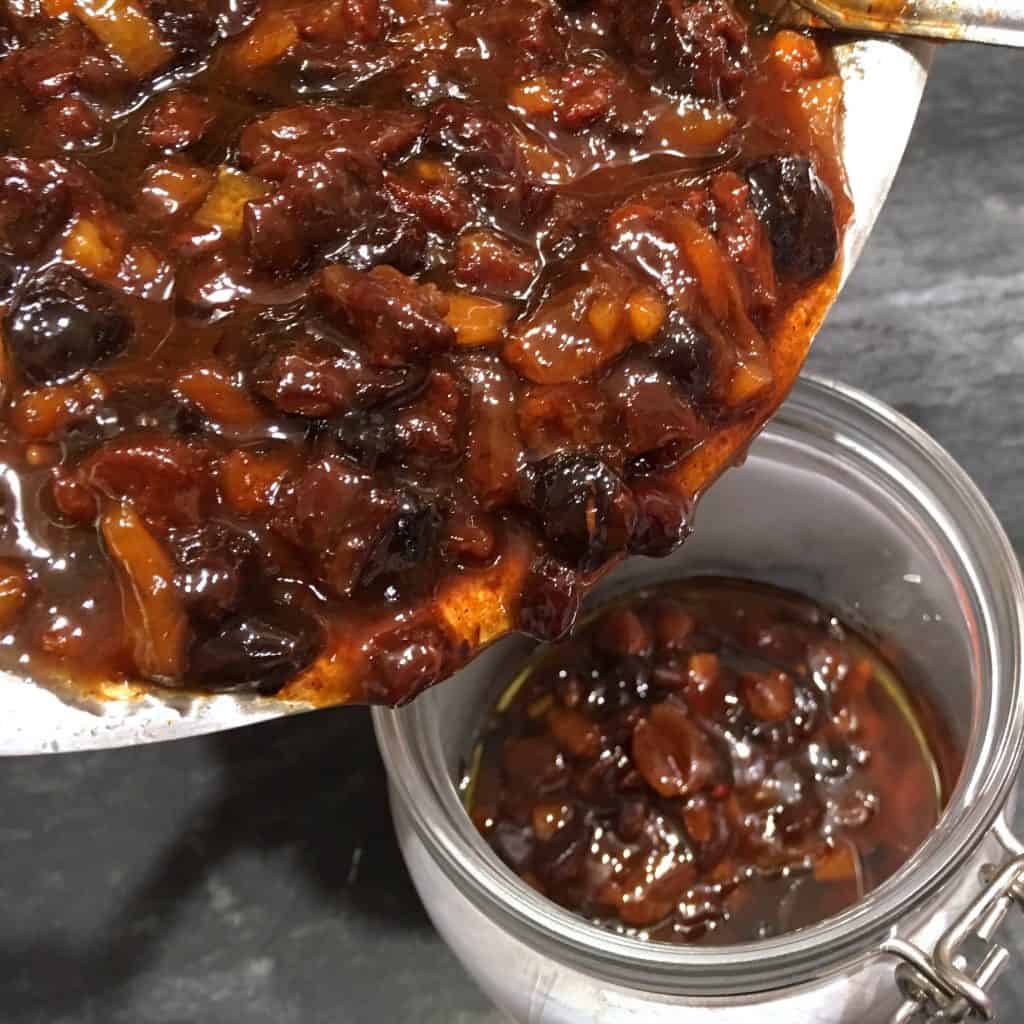
The liquid suet on top will gradually harden into a protective layer which will enable you to safely store your mincemeat.
**For instructions on different methods for storing your mincemeat, including how to can it for long-term storage, see the blog post section above on Preserving.
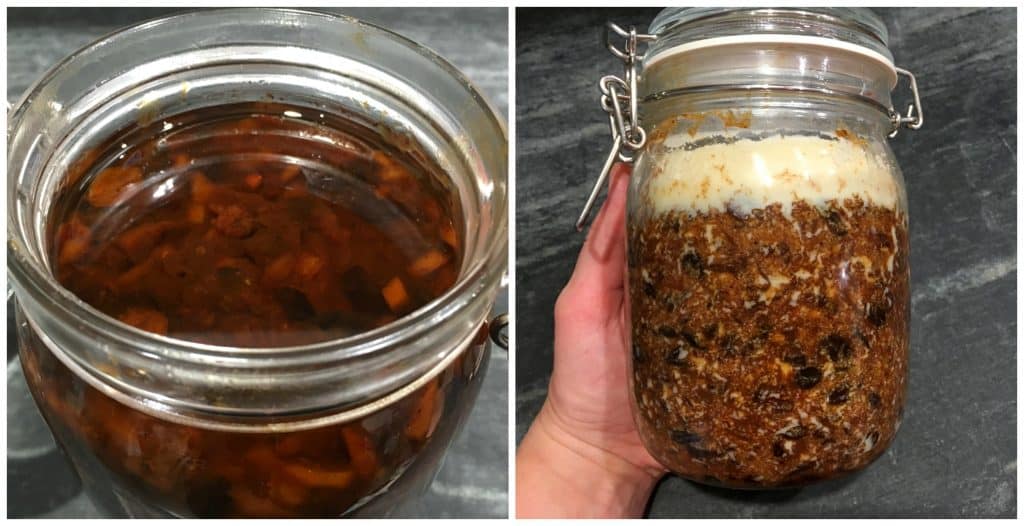
This mincemeat is delicious used immediately but for optimal flavor let it sit in the refrigerator for 1-2 weeks before using. If you’re including the beef in your mincemeat and plan on storing it for longer than a couple of weeks, follow the instructions above for pressure canning your mincemeat.
Now you’re ready to use this mincemeat to make homemade Mince Pies! Or create your own twists by using it for things like mincemeat cake or mincemeat muffins
Enjoy!
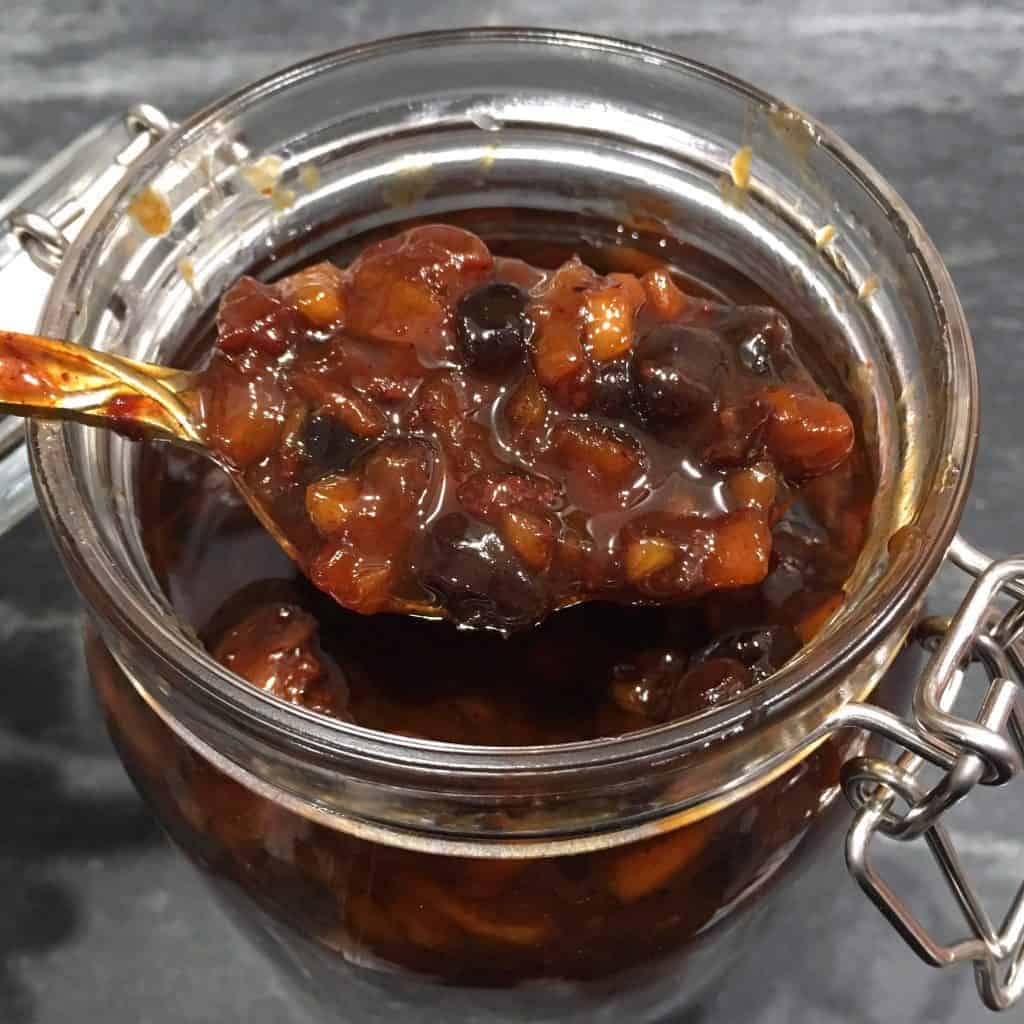
For more delicious traditional British treats, be sure to try our:
- Sticky Toffee Pudding
- Lardy Cake
- Eccles Cakes
- Spotted Dick
- Bara Brith
- Barmbrack
- Mince Pies
- Scottish Shortbread
- Yorkshire Parkin
- Flapjacks
- Victoria Sponge Cake
- Crumpets
- Millionaire’s Shortbread
- Yorkshire Pudding
- Figgy Pudding
Save This Recipe
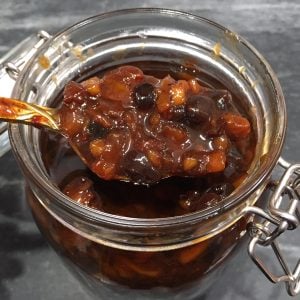
BEST Traditional Mincemeat
Ingredients
- 1 pound (450 grams) finely chopped beef steak , (optional but HIGHLY recommended, otherwise use an extra 1 1/2 cups raisins or currants) **Use a well-marbled cut so it will be tender after the long cooking time; if the cut is lean it will become over-cooked and tough
- Note: Traditionally made with beef or lamb and can also be made with wild game
- 1 1/4 cups (190 grams) raisins
- 1 1/4 cups (190 grams) currants
- 1/2 cup (80 grams) golden raisins
- 2 cups finely chopped tart apple
- 7 ounces (200 grams) shredded beef suet (you can also ask your local butcher for fresh beef suet ground through a fine meat grinder)
- 2 cups (450 grams) packed dark brown sugar
- 2 tablespoons candied lemon peel
- 2 tablespoons candied orange peel
- STRONGLY recommend using Homemade Candied Citrus Peel (click link for recipe)
- 1 1/2 tablespoons (25 grams) finely chopped blanched almonds
- 1 lemon, its zest and juice
- 2 tablespoons apple cider vinegar
- 1 1/2 teaspoons ground cinnamon
- 1/2 teaspoon ground nutmeg
- 1/4 teaspoon ground cloves
- 1/4 teaspoon ground allspice
- 1/4 teaspoon ground mace
- 1/4 teaspoon ground ginger
- 1/4 teaspoon ground coriander
- 2 tablespoons brandy
- 2 tablespoons dark rum
Instructions
- Combine all ingredients except for the brandy and rum in a medium-sized pot and slowly bring to a simmer to prevent scorching. Reduce the heat to LOW and simmer uncovered for about 2 hours, stirring occasionally, more towards the end to prevent burning. (If the liquid reduces too soon and the mincemeat starts to stick/scorch on the bottom, add a little bit of apple juice or water.) Stir in the brandy and rum. (Note: If you prefer to have the alcohol cooked out, add them at the same time as the other ingredients.)
- Spoon the hot mincemeat into sterilized jars (spooning it in the jar while hot will ensure the suet rises to the top to create a layer of fat). As the mixture cools the suet will harden, creating a seal to help preserve the mincemeat. *If you're including the beef be sure to refrigerate the mincemeat. If you're storing it for more than a couple of weeks follow the directions in the blog post for pressure canning the mincemeat for longer-term storage.See blog post for additional ways of storing your mincemeat.
- Makes about 1 quart. Feel free to double, triple, etc, as needed.
- Use this mincemeat to make Homemade Mince Pies! (click link for recipe)
- Note: Mincemeat is traditionally stored for several months before using to allow time for the flavors to deepen, however this mincemeat is also delicious eaten within just a few days.
Notes
Nutrition
Originally published on The Daring Gourmet December 16, 2017



















I tried this recipe for the first time. This was my first making mince meat. I didn’t add meat but followed the directions precisely. Unfortunately after cooking for two hours on low heat in a stainless steel pot,it was hard as a rock, and everything has reduced, no sign of apples or almonds, just one dark lump. After doing a little realized that I cooked it too long, but this was the recommended time. I suggest you change the recommended cooking time. I tried adding water and reheating, but this did not help!
This has come out great. I had to make a few adaptions due to the availability of ingredients, but the taste is amazing! I am living in Germany so I have adapted it accordingly and used grams instead of cups
– I couldn’t find currents or golden raisins, so decided to add up to the total quantity of dry fruits needed.
– no meat so I added 228g to dry fruits.
– 688g of dry fruits = 390g Sultanas, 150g raisins, 100g cranberries (chopped finely), 40g dates (they needed to be used up).
– I couldn’t get suet which was a real shame. I used 135g of leftover vegetable suet I brought over with me and 50g of pork lard.
– Mace – I finally found it after a long time of searching, but it was too expensive to justify 1/4 teaspoon :( so I just left it out.
– Cooking. So I used my instant pot. I put everything in the pot as you suggested, turned on saute mode to bring everything together, then once juicy and combined I turned on slow cooker mode, high for 5 hours. (based on https://myfoodbook.com.au/tips/converting-an-oven-or-stovetop-recipe-to-a-slow-cooker-recipe).
– I am going to keep searching for suet for the next batch, I might even brave the meat version.
Thank you for this recipe, I am really looking forward to sharing mince pies with my colleagues at work and my German family members, giving them a taste of my favourite Christmas food.
I’m so happy you enjoyed it, Lauren, and thank you for that detailed info and feedback!
Could this be cooked in an Instant Pot?
Hi Sharon, possibly but I’m not sure how suitable this would be to the IP.
I have just made this recipe in the instant pot on slow cooker setting.
I put everything in the pot as was suggested, turned on saute mode to bring everything together, then once juicy and everything combined I turned onto slow cooker mode, high for 5 hours. (based on https://myfoodbook.com.au/tips/converting-an-oven-or-stovetop-recipe-to-a-slow-cooker-recipe).
Hi. Could you suggest substitutes for the alcohol? I would like mine to be alcohol free.
Hi Shazni, the function of the alcohol is also in part to help preserve the mincemeat for long-term storage. But if you’d like to omit it you can use apple juice in its place.
Can you use Lard in place of Suet. I can not find it.
Hi Kathy, they’re not entirely interchangeable but you can use lard if you need to. However, if you use lard avoid the store-bought stuff that comes in blocks; it will make make your mincemeat taste “porky”, plus it’s usually hydrogenated. If you use lard it really needs to be lard that’s rendered from what’s called kidney fat – also known as leaf lard or leaf fat. It’s the fat the surrounds the kidneys on a pig and has a very mild flavor; it’s the kind that’s used in baking. (As opposed to most lard you find in the stores that’s rendered from back fat, has a stronger flavor, and is used for frying/cooking.) I suspect though that if you’ve had a hard time finding suet you’re going to have an equally difficult time finding leaf lard. I would look up butchers in your area – not the meat department in grocery stores but an actual independent butcher. Any of them will know exactly what suet is and you can ask them to finely grind it for you. If all else fails and find suet at a butcher or order it online, and you can’t find rendered leaf lard, then use butter.
P.S. I just looked the Atora suet up on Amazon and can’t believe they’re currently charging $20 per box, that’s insane!! I don’t know what they’re thinking but hopefully they adjust that price before long.
Both my grandmothers had recipes for mince(meat) and MINCEDmeat. The first version (mince/mincemeat) was made solely with available dried fruits(though not raisins)and brandy while the MINCEDmeat version was half available beef, venison and pork scraps and half chopped green tomato, dried apple and dried pear with whisky or moonshine. Both use the same spices and beef suet or butter. My grandmothers would make big batches of both and can them for use year round. They each bought one of the first publicly available pressure canners so they could safely can the meat version. I do remember them dating the jars carefully so they didn’t touch them for at least six months. Mom never made it, she used the dried Nonesuch mincemeat and I never liked it. (I also remember both Grandma Croft and Grandma Mortimer serving hot MINCEDmeat pie for supper with greens on the side.)
I used to make mincemeat like this, just after Christmas and keep it for the following Christmas!
The main difference is I used brandy and sherry rather than brandy and rum.
Maybe I will try rum next time.
Unfortunately I have lost my recipe.
However, one of the important ingredients was suet.
I used to get it from my butcher, but Atora is great too.
I am very lazy these days, so I buy Walkers mince pies….
Have fun making mincemeat. It’s a great tradition.
I grew up close to Lexington, Kentucky and every year we would have homemade mince meat pies at Christmas. Sooo good with hot coffee. It was one of my favorite desserts. Haven’t had a good mince meat pie since my aunt passed away but I’m going to try this recipe.
My grandmother was a Midwest farm wife in the depression, and a a child I remember her making mincemeat with actual beef. It was DELICIOUS!(except that one year when she was tired or lazy and used ground beef. That was weird, do not recommend) I am going to make your recipe for my own children and grandchildren next year, to keep up the tradition.No ground beef though!
Hello! I made mincemeat pies last year for Christmas, using this recipe and venison instead of beef. Everyone was amazed at how good it tasted! I’m making it again as we speak (type) as well as the candied citrus.
After making *real* mincemeat I will never again buy the jarred stuff from a store.
I’m so glad to hear that, Jerry, thank you very much for the feedback!
I am a Yorkshireman transplanted to South Carolina. Over the years I have limped by using Borden’s None Such Mincemeat to make my Christmas mince pies. It’s just not the same. When I happened across this recipe while searching for a Yorkshire Parkin recipe, I simply had to try it and I am so glad I did. It has the right flavors and consistency I remember from when my Grandma made her mince pies. I made my own glacé cherries and candied citrus. I used minced lamb for the meat. Got the suet from the Publix butcher for free! L I also added chopped dates and quince. Champion!
You’re a rock star, Dr. Alan! I’m so glad you made the effort to take those extra steps in making your own candied citrus and glacé cherries and that the results were a success – thank you!
Love this recipe! But made a bit too much! I have popped a pie in the freezer. Other than mincemeat pies or tarts, do you have any other ideas/recipes for the leftovers.
Thank you!
Thank you, Mary! Here are a few ideas: https://www.theguardian.com/lifeandstyle/2021/dec/21/too-much-mincemeat-10-delicious-recipes-to-make-the-most-of-it-or-even-reuse-mince-pies You can also add some to muffins and cakes.
My mom made mincemeat filled sugar cookies. Just cut out round coolies, put a tblsp of mincemeat on one, top with another cookie cut an X in the top to vent and seal around the edges. Yum!
Followed the recipe faithfully, the fat didn’t rise to the top and the whole mixture is very greasy and without the flavour that I remember.
The same thing happened to me. The fat did not rise. way too greasy. I’m tossing the whole batch. such a waste!
Hi Barb and Jane, what kind of fat did you use? Was it the recommended shredded beef suet?
I made this recipe yesterday and the suet didn’t rise it just encased all the fruit and i used Atora. I’m hoping it doesn’t spoil the pies when I make them.
Hi Jae, no it won’t spoil the pies. You’ll end up with perfectly delicious, flaky mince pies. Happy baking! :)
Thanks for the recipe. I couldn’t find mincemeat at any local shops this year so made your recipe (mostly). Thankfully, even the Stop and Shop butcher here in Connecticut stocks beef suet around Christmas. I left out the beef and nuts and used a cup of chopped frozen cranberries. I had cognac on hand so used that to soak the fruit and peel overnight before cooking with the sugar, spices and grated suet. No way this will be aged for two weeks, but what can you do? Must make pies! Merry Christmas
Awesome, I’m glad it was a success, Sidney, thank you!
I made this recipe with suet (fresh suet from the butcher) but without meat. I did not end up with a thick layer of suet on top as you show in the photos, despite putting the hot mixture into hot jars and letting them sit until cooled. I took your advice and candied my own peel, and glad that I did! The mincemeat is delicious, tastes like what my mum used to make, but it is very, very thick and sticky, almost like toffee. To make my mince tarts, I have to add some more lemon juice and brandy (which is not a problem!) I will definitely make more next year!
Hi Janis, becoming overly thick and sticky is a result of over-cooking. It’s like with candy-making, the sugars will caramelize and reach soft ball stage (then eventually hard ball stage, etc) and become thicker in the process. You can thin it out a bit though by reheating with some additional water. I’m glad you enjoyed the flavor and will be making it again!
Hi,
I haven’t started cooking yet but I am worried that I am not starting with enough liquid in the mix. Will liquid form as I start cooking? The mixture is mostly dry with just a slight dampness.
Hi Daniel, yes, there will be plenty of liquid as the suet and the sugar melt. Just be sure to heat it slowly so the mixture doesn’t scorch.